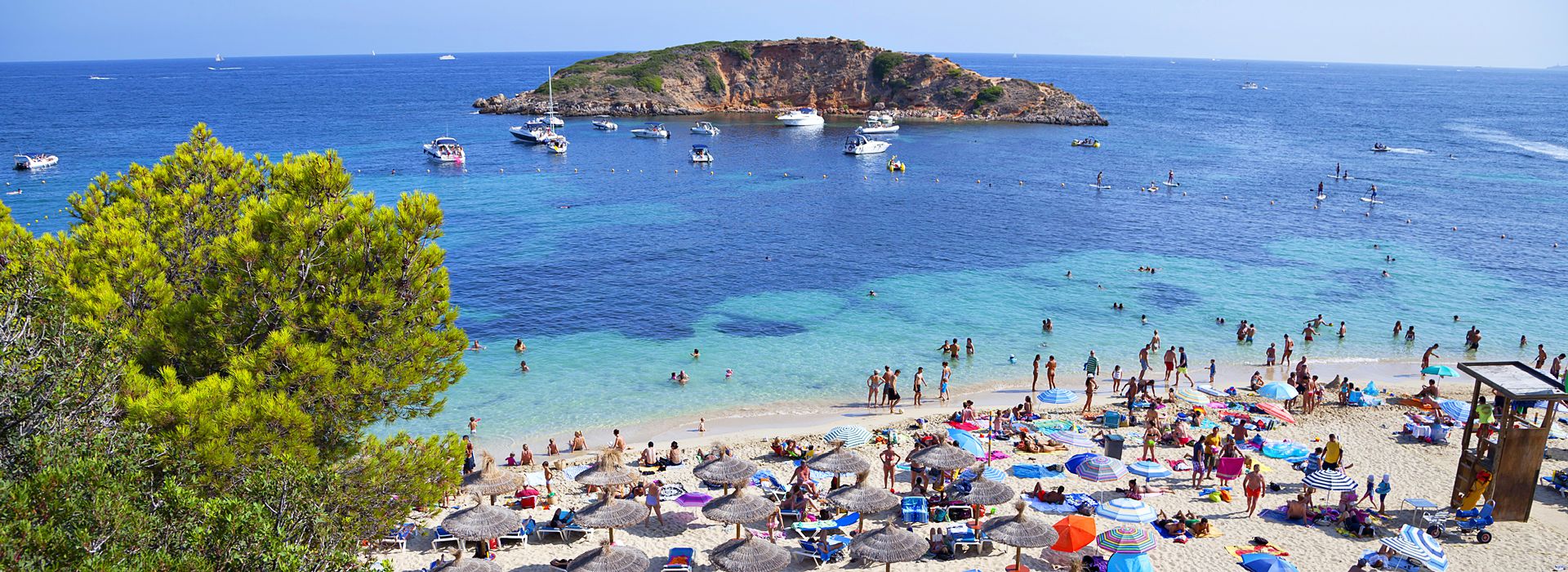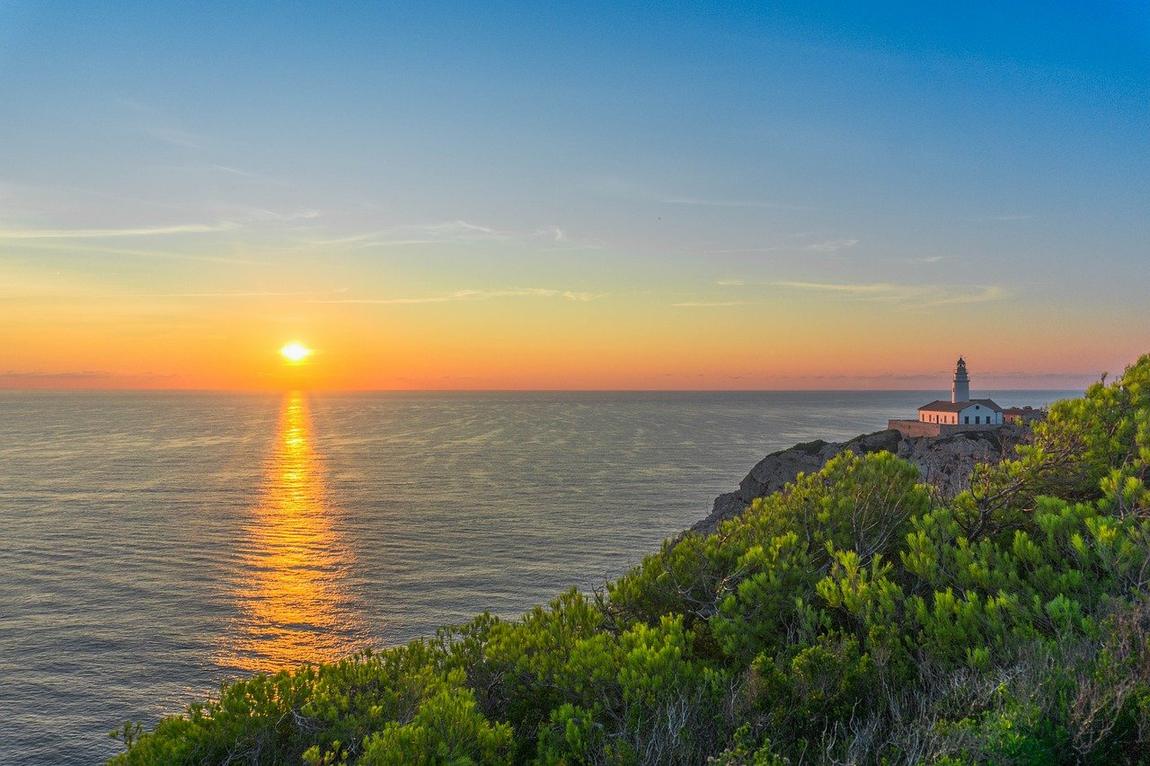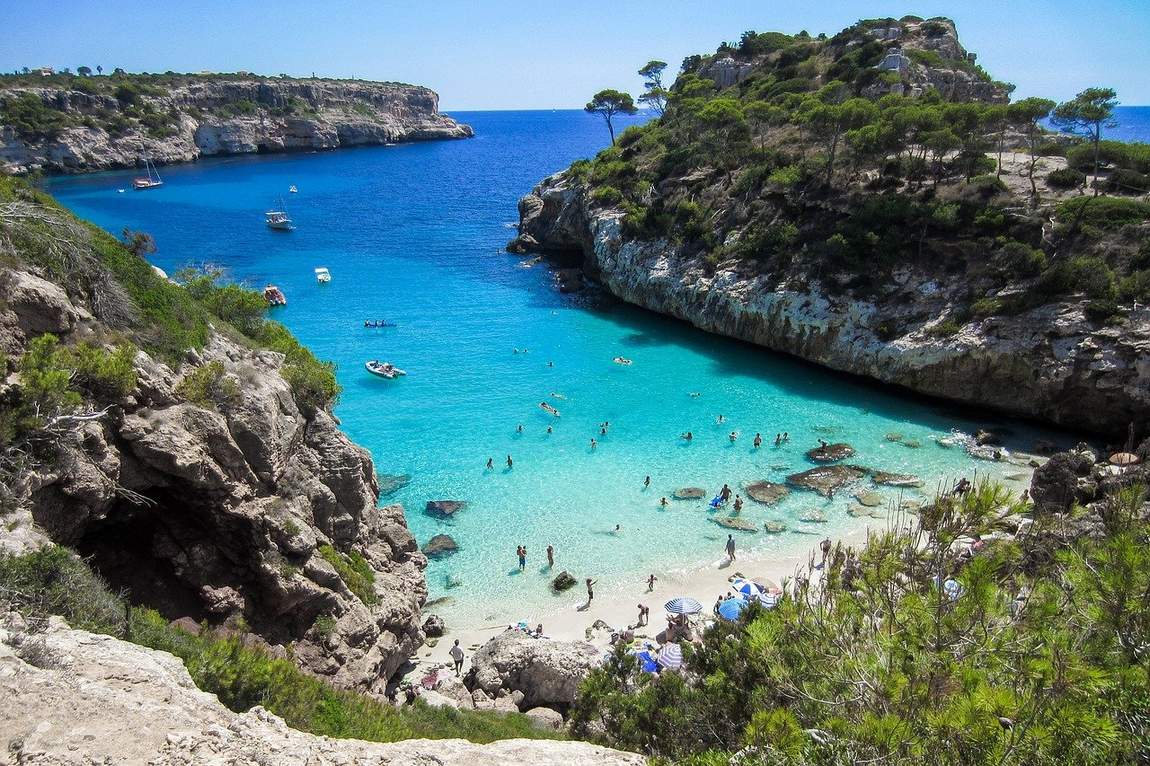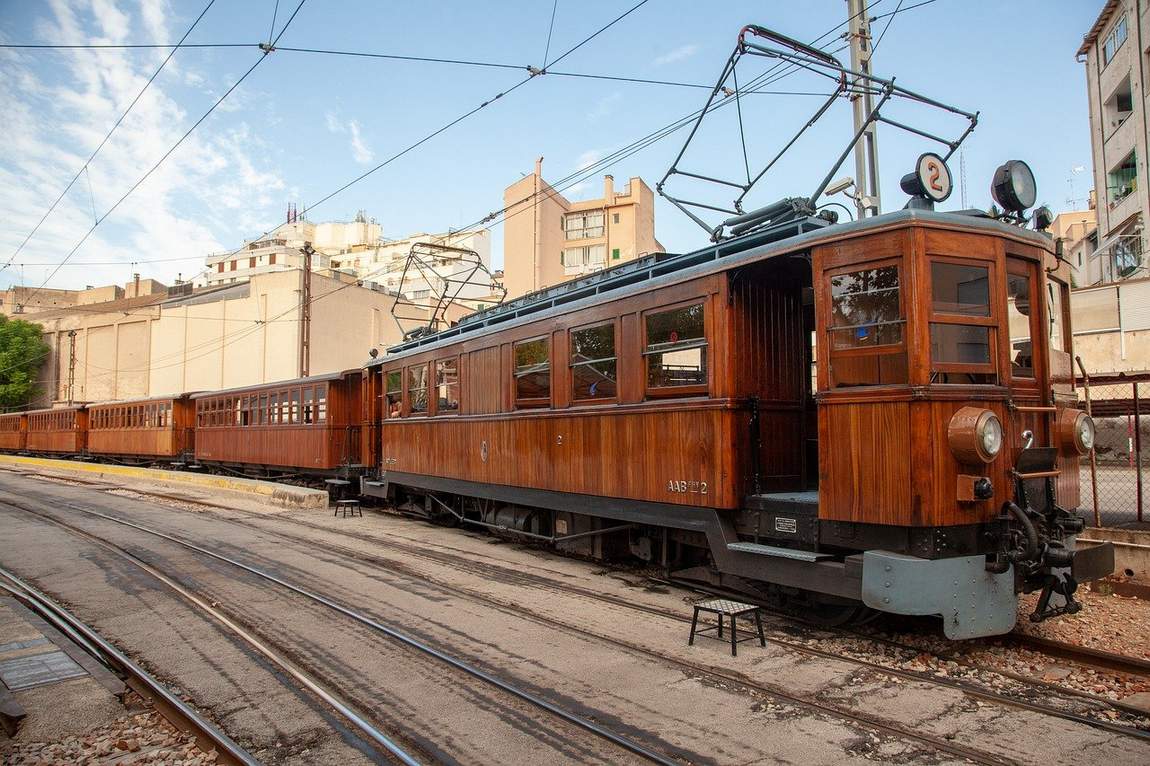What does travelling to an island mean to a child? Endless expanses of sea, sandy shore, hot sun, lush vegetation (definitely palm trees with bananas and coconuts) and adventure, including encounters with pirates.
It is precisely what the Spanish island of Mallorca looks like. However, the beauty of the landscape is added to excellent tourist infrastructure and safety. And, of course, a warm, sunny climate contributes to family holidays.
One of the main priorities of the tourist business is a holiday with children in Mallorca. Hotels, restaurants, entertainment and health services are all geared towards it. Kidpassage has gathered all the essential information about Mallorca's resorts. Find out when it's best to come to the island for sunbathing and how to choose a good holiday destination for your child.
Mallorca on the map of Spain
Mallorca is the largest of the Balearic Islands in the Mediterranean Sea. Mallorca is 8 km from Playa de Palma and C'an Pastilla, 13 km from Illetas, 15 km from Palma Nova, 18 km from Magaluf, 22 km from Santa Ponsa, 25 km from Paguera, 65 km from Cala d'Or and 60 km from Alcudia. Palma de Mallorca, the island's capital, is 275 km from Valencia and Barcelona by sea.
Finding Mallorca on the map is easy. Although it is smaller than the island of Sardinia, located 400 km, it is still impossible not to notice. The island has been spotted before: Mallorca was fought over by armies of different nations until the Balearic Islands became part of Spain in the 18th century.
Mallorca for Kids

Holidays in Mallorca are a mix of the exotic and the mundane in just the right proportion. On the one hand, it's an island steeped in pirate legends. Conversely, Spanish ordinariness means great hotels, clean beaches and delicious food.
In many ways, holidays in Mallorca with children are similar to holidays in other resort regions of Spain. It's a construction set: you have everything you need for a relaxing holiday, a lot of travelling, and a lot of fun. You can put it all together as you see fit.
And yet, it has to be said that Mallorca is best appreciated by those who like to rent a car and drive around, discover the backdrop of non-resort life and get away from the hustle and bustle of the city. The island lacks large-scale attractions but has a lot of natural beauty.
Mallorca also has plenty of activities for children. However, a trip to several neighbouring resorts will be necessary to organise a varied entertainment programme.
But you need to pay tribute to a quiet pastime. If you want to enjoy a calm holiday with your child in a resort with a lovely beach and a comfortable hotel, Mallorca is the best place to go. There are plenty of sites on the island where you can bring your baby and enjoy the peace. The only downside is the difficulty of the transfers. In most cases, travelling to Mallorca will involve a connecting flight, although there are direct flights in high season.
Best time to travel

Fact: Mallorca hosts dozens of festivals, fairs and celebrations throughout the year, most in winter and early spring. However, Mallorca's high season is primarily beach, and the May to September holiday season is the peak season. The island is bustling during July and August when hotels are booked up almost a year in advance.
Recreation in May and the first half of June has its peculiarities. The first is a rather cold sea. The hotel swimming pool or a water park can be a great help. The second is a small number of regular international flights. You may have to look for a suitable charter or take a connecting flight.
It's wise to arrive in time for the opening of the Mallorca season if you want to travel around the island rather than lie on the beach.
The weather at the end of spring favours the active traveller:
- It's not yet hot.
- The rains are rare.
- The sun is not yet too scorching (but a hat is still a must for holidays in Mallorca).
When should you go to Majorca if beach holidays are more of a priority? In this case, you can safely choose the low, action-packed season. A succession of celebrations follows Christmas and New Year's Eve: On 18-20 January, Palma celebrates St Sebastian's Day, the city's patron saint. The end of February sees the Mallorca Carnival - Sa Rua. An integral part of the festival is Sa Rueta, a carnival for children.
On the first day of March, the Balearic Islands Day is celebrated with popular festivities and merriment. April sees the Princess Sofia Trophy sailing regatta. October and November are devoted to various agricultural fairs, including pumpkin, olive and wine.
High season highlights include the Moors and Christians Festival in May, the Night of Fire and the St. Juan's Bonfires in June.
Weather and Сlimate

Mallorca's climate is typically Mediterranean, with sunny summers and mild winters. The island has two seasons, a hot summer from May to October and a warm spring (or autumn) from November to April.
Those who have been pining for a beach holiday over the winter can plan their Mallorca holiday as early as the beginning of May. The average daytime temperature in May is around +23° C, but sometimes it can be hotter than 30° C or colder, as low as +18° C. In any case, you should take some warm clothes with you because, during the night, the temperature in Mallorca can drop to 12-15°C.
Mayorcan holidays with children usually begin in June because the sea does not get warm enough in May. The air temperature rises to +27-28°C when summer arrives, and the water becomes warm.
Mallorca's hottest weather is in July and August. Temperatures start around 30°C in the morning and heat up to 35°C by midday.
The heat is less noticeable, thanks to the moderate humidity and refreshing breeze, but you're still better off on a beach holiday during the morning and evening hours. By the way, Mallorca's summer evenings are pleasantly cool, with temperatures dropping to between 20-24ºC.
If you feel that a good holiday is best achieved with mild weather, a warm sea and no crowds on the beach, opt for September. September brings the end of the holiday season, with temperatures dropping to 26ºC and the sea retaining its summer warmth — it's the best time to be on Mallorca with the kids.
On the other hand, October's weather is unpredictable in a good way. Temperatures are usually around +22ºC in mid-autumn, but October is often hot and sunny, resembling summer. It is a time to bring your baby to Mallorca without the heat and scorching sun.
From November to April, temperatures fall between +14 and 19ºC in Mallorca. But even then, there are no more frosty days than sunny ones. In contrast to summer, when there is hardly any rain, late autumn, winter, and early spring are rainy times.
Sea Temperature

Mallorca doesn't experience cold weather as we know it, but the beach season starts in May, and the bathing season is even later. In May, for example, Mallorca's beaches are already full of sunbathers but hardly any bathers: the sea temperature barely reaches +19°C.
The situation changes for the better in June. By the middle of the month, the water gets as warm as +23°C. During July and August, the water temperature in Mallorca is around +25-26°C; during prolonged heat, it can rise to +28°C. The sea remains warm throughout September, although the temperature gradually drops to around 24°C. The bathing season often lasts throughout October as the water retains a temperature of 22-23ºC and only cools to 20-21ºC towards the end of the month.
Food

Meals in Mallorca hotels are rarely included in the room rate. Tourists usually eat outside the hotels in local restaurants, especially as children greatly appreciate Mallorca's culinary traditions. Pa amb tomàquet is an excellent quick snack dish consisting of slices of toasted bread spread with a mixture of tomato, olive oil and garlic. The bread can be topped with sausage or cheese.
Among Mallorcan desserts, children love the ensaïmada, a sweet bun with yeast dough rolled up into a spiral.
If you prefer to cook on your own, you can buy all the products you need from supermarkets. They can be found almost everywhere, but there are only small shops in some towns. All resorts also have their market day, when fresh fruit, vegetables, meats and cheeses are sold.
Getting Around

Public transport in Mallorca is ordinary and surprising at the same time. It includes buses, the city metro in the capital and two modern and vintage trains. TIB runs all this: its website has detailed information on routes, timetables and fares.
The most convenient form of transport in Mallorca is buses. They can take you anywhere on the island. There are about a hundred routes, almost half of which work only during the high season when tourists must get to the resorts.
Fares on the buses depend on the distance. For example, a ticket from Palma to Santa Ponsa costs €3.40, Alcudia €5.40 and Cala d'Or €8.40. For frequent travel, you can buy a T20 or T40 card. Tickets are sold only by the drivers.
Its price depends on the zone of validity and is €16.80-51.40 for a 20-ride card and €25.20-77.25 for a 40-ride card. The zoning scheme is relatively complicated, but the TIB website indicates for each route how many zones crosses. There is no discount on single tickets for children, but buying a youth card with a 50% discount on fares is possible. The youth card can be used by people aged 4 to 25. Children under four years of age can travel for free.
There are city buses only in the island's capital, with several taking you to nearby resorts.
City bus number 3 goes from Palma to Illetas, and numbers 15 and 25 to Can Pastilla and Playa de Palma. The fares are €1.50 to the city, €3 to the port, and €5 to the airport.
The metro in Palma de Mallorca connects the city centre with the suburbs inland. It is more of a sightseeing transport, like the trains going to the Inca, Sa Pobla and Manacor. Only the decorative old Palma-Soller train takes you to the coast (admittedly not a resort, but very scenic).
Whether or not to take a taxi to get around Majorca depends on the situation. For example, the only way to get from the airport to the resort at night is by taxi. The fare includes a boarding fee (about €4) and a charge per kilometre (about €1.5). For active travel, it is handy to rent a car. Majorca has good roads, plenty of parking, and even free. The offices of car rental companies are located at the airport and in all the resorts.
 [email protected]
[email protected]






.jpg)



.jpg)

.jpg)

.jpg)
.jpg)








